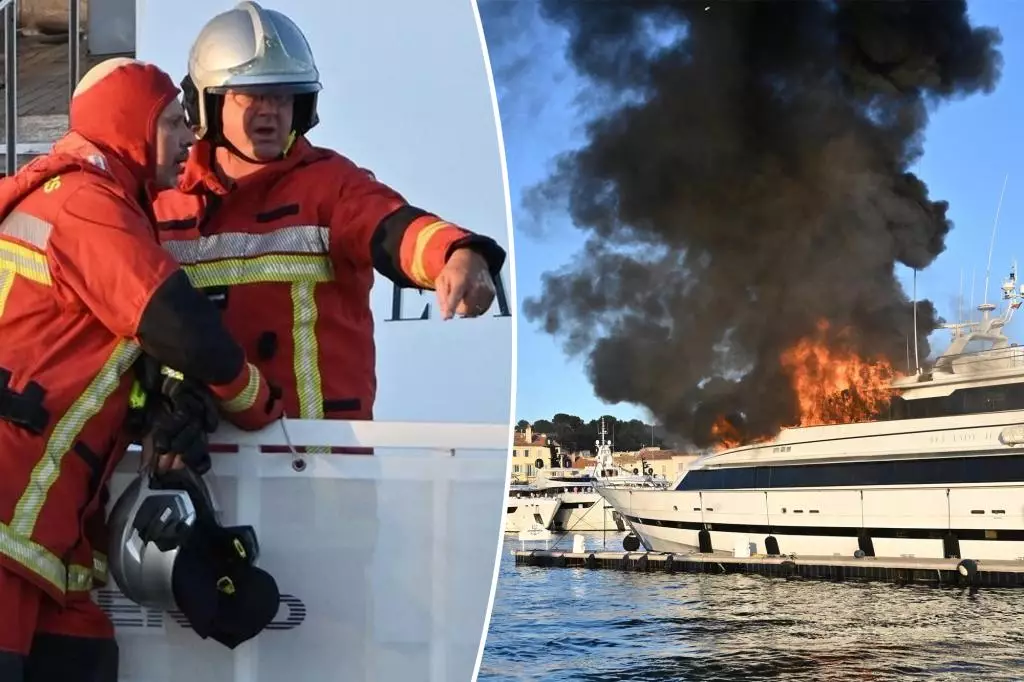St. Tropez has long been celebrated as a playground for the wealthy and privileged, an epitome of exclusivity and luxury. The recent incident of a multimillion-dollar superyacht engulfed in flames right at its port underscores a glaring paradox: the fragility hidden behind its glossy veneer. While onlookers — draped in designer wear and sipping champagne at trendy venues like Crazy Pizza — enjoy the spectacle of opulence, the lurking risks remain overshadowed. The blaze of the Sea Lady II signifies more than just a mishap; it highlights how superficial appearances often conceal vulnerabilities that can erupt without warning, even amidst the most secure-looking settings.
This event also reveals how obsession with extravagance can momentarily blind society to the genuine dangers that these floating palaces face—from technical failures to unpredictable emergencies. It challenges the common perception that luxury equates to invincibility, forcing us to reconsider the true costs behind the glamour. The fact that the yacht’s blaze drew minimal concern beyond fleeting curiosity points to a cultural normalization of excess, desensitizing us to potential tragedy. The crowds, instead of sympathizing with the crew’s peril or pondering safety measures, continued their revelry, echoing a societal tendency to prioritize spectacle over caution.
The Illusion of Perpetual Celebration and the Hidden Toll
Celebrities and the jet set flock to St. Tropez during high season, with no signs of slowing down. Kylie Jenner, Timothée Chalamet, Kendall Jenner—these names symbolize youth, wealth, and an unattainable lifestyle that many admire or envy. Their presence transforms the town into a living tableau of excess, where the flames of one yacht barely register amid the neon glow of parties, beach outings, and lavish dinners. It is as if tragedy is just a fleeting interruption in an otherwise unending celebration of superficial riches.
Yet, beneath this frolic lies a stark truth: the high cost of maintaining such a lifestyle. The Sea Lady II’s $76,000 weekly charter fee illuminates the staggering disparity between the rich and the rest of society. While the wealthy indulge in shimmering yachts and exclusive parties, the risk of accidents—be it fires, mechanical failures, or even environmental damage—remains an unspoken cost of this luxury. The 2017 yacht fire along Pampelonne beach, which resulted in sinking, serves as a grim reminder that tragedy can strike unexpectedly. Such incidents also pose environmental concerns, with pollution barriers being deployed to prevent ecological damage—another hidden consequence of excess.
Furthermore, the scene of smoke swirling amid the festivities exposes societal indifference to safety. Crew members, risking their lives and suffering from smoke inhalation, are rarely acknowledged in the headlines. Their peril is overshadowed by the spectacle of the blaze and the spectacle of wealth itself. The luxury yacht, equipped with jet skis, wakeboards, and snorkeling gear, embodies the leisure fantasies many fantasize about but rarely comprehend the risks involved.
The Cycles of Construction, Consumption, and Collapse
The recurrence of yacht fires in the French Riviera prompts a critical question: is this alarming, or merely accepted as part of the territory? The glamour of celebrity sightings, such as Jeff Bezos’s extravagant wedding or the Jenner sisters’ European tour, reinforces a culture that values conspicuous consumption over sustainability or safety. The burning of a yacht—an expensive, high-tech vessel—acts as a symbol of the ultimate indulgence that can turn to ash in moments.
This cycle reveals society’s complex relationship with wealth: an obsession with ownership, fame, and display that often blurs the lines between celebration and recklessness. It also raises ethical questions: at what point does the pursuit of luxury become unsustainable, or even irresponsible? The environmental impact of such lavish vessels, and the risks they pose to human life, are often ignored amid the glamor. Burning yachts, which sometimes emulate the destruction of the very visions of greatness they represent, serve as stark metaphors for the transient nature of material grandeur.
As the high season in St. Tropez unfolds, the allure remains irresistible to many. But it’s crucial to recognize that beneath the polished surface lies a delicate balance—one that is easily disrupted by fire, mishap, or neglect. The tragedy of the Sea Lady II’s fire should be a wake-up call, challenging us to rethink the true cost of glamour and the illusions we chase. Wealth can buy splendor, but it cannot fully shield us from the vulnerabilities that lurk beneath the opulence.

